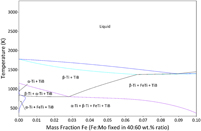Crossref Citations
This article has been cited by the following publications. This list is generated based on data provided by
Crossref.
Sichevych, Olga
Flipo, Sever
Ormeci, Alim
Bobnar, Matej
Akselrud, Lev
Prots, Yurii
Burkhardt, Ulrich
Gumeniuk, Roman
Leithe-Jasper, Andreas
and
Grin, Yuri
2020.
Crystal Structure and Physical Properties of the Cage Compound Hf2B2–2δIr5+δ.
Inorganic Chemistry,
Vol. 59,
Issue. 19,
p.
14280.
Degnah, A.
Du, J.
and
Ravi Chandran, K.S.
2020.
CALPHAD Approach and processing of a multicomponent titanium matrix composite for high strength and fracture toughness.
Materials Science and Engineering: A,
Vol. 781,
Issue. ,
p.
139210.
Monisha, K.
Shariff, S.M.
Manonmani, J.
and
Senthilselvan, J.
2021.
High power diode laser alloying of TiB2 and amorphous-boron with titanium: Phase, microstructure and hardness analyses.
Optik,
Vol. 239,
Issue. ,
p.
166758.
Chang, Shih-Hsien
Liang, Che-Hsuan
Huang, Kuo-Tsung
and
Liang, Cheng
2021.
Evaluation of the microstructures, strengthening mechanisms and corrosion behaviors of TiB2 powder added to Ti–8Ta–6Ni alloys through the vacuum sintering process.
Journal of Alloys and Compounds,
Vol. 857,
Issue. ,
p.
157629.
Schramm Deschamps, Isadora
dos Santos Avila, Daniel
Vanzuita Piazera, Enzo
Dudley Cruz, Robinson Carlos
Aguilar, Claudio
and
Klein, Aloisio Nelmo
2022.
Design of In Situ Metal Matrix Composites Produced by Powder Metallurgy—A Critical Review.
Metals,
Vol. 12,
Issue. 12,
p.
2073.
Kovalev, D. Yu.
Bolotskaya, A. V.
and
Mikheev, M. V.
2022.
Self-Propagating High-Temperature Synthesis in the Ti–B–Fe System with AlN Additions.
Inorganic Materials,
Vol. 58,
Issue. 9,
p.
922.
Hitit, Aytekin
Yazici, Ziya Ozgur
Şahin, Hakan
Öztürk, Pelin
Eryeşil, Buğrahan
and
Barut, Nusrettin
2022.
Microstructure and Mechanical Properties of CoWB Based Composites Produced by Crystallization of Ni-Co-Zr-Ta-W-B Bulk Metallic Glass.
Metals,
Vol. 12,
Issue. 2,
p.
251.
Bolotskaia, Anastasia
Avdeeva, Varvara
Bazhin, Pavel
Mikheev, Maksim
Stolin, Alexander
Novikov, Vseslav
Kovaleva, Marina
and
Sirota, Viacheslav
2023.
Coatings Prepared by Electro-Spark Alloying with SHS Electrode Materials Based on Ti-B-Fe-AlN.
Coatings,
Vol. 13,
Issue. 7,
p.
1264.
Medvedovski, Eugene
2023.
Advanced ceramics and coatings for erosion‐related applications in mineral and oil and gas production: A technical review.
International Journal of Applied Ceramic Technology,
Vol. 20,
Issue. 2,
p.
612.
Degnah, A.
Alnaser, H. F.
Al-Helaly, I.
Haddad, M. Y.
Al-Aredai, A.
Alsaif, F.
Alkhaibari, S.
Alotaibi, M.
Abuobaid, M.
and
Kurdi, A.
2024.
The Al2O3 Effect on Kevlar Composite for Armor Applications: Prediction, Validation, and Simulation for Ballistic Impact Testing.
Journal of Materials Engineering and Performance,
